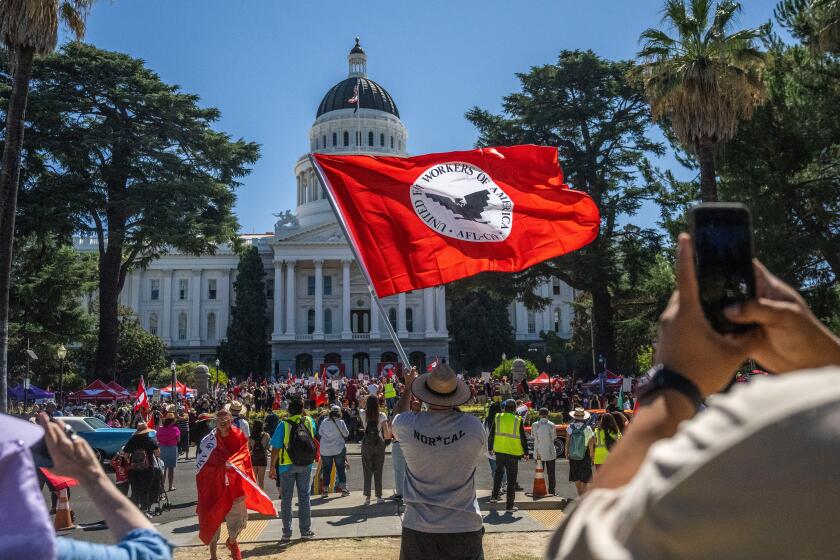Increase in Prices Eases Pressure on Oil Officials : Stakes Lower; Producers Unlikely to Trim Output
Whatever this week’s unprecedented meeting of OPEC and non-OPEC oil ministers might bode for long-term cooperation between the two groups, shifting economics appear to have made the sessions less urgent than they seemed just a few weeks ago.
Several events--notably recent evidence of strong increases in demand for oil in Europe, the United States and Japan--have served to drive oil prices up since a divided Organization of Petroleum Exporting Countries called the extraordinary meetings. Observers believe that could make it harder for the 23 disparate nations represented here--not counting the state of Texas--to agree to significantly cut oil production.
“OPEC has never held to its quota in a time of rising prices,” said an economist for one of the largest oil producers in the Middle East.
When the cartel agreed April 9 to meet this week, prices for OPEC grades of crude oil had been falling for several weeks to $4 or $5 below the official benchmark of $18 per barrel. Several non-OPEC nations were losing so much oil revenue that they approached OPEC to say that if the cartel would cut production, so would they.
Today, news of the meeting itself, renewed hostility in the Persian Gulf, the approach of seasonal upswings in oil markets and the latest demand figures from industrial nations have caused prices to partly recover those losses, and the outlook is for continued increases this year.
Stakes Aren’t as High
On the New York Mercantile Exchange Monday, contracts for June delivery of West Texas Intermediate, the benchmark U.S. crude, settled at $18.40 per 42-gallon barrel, up 10 cents from Friday’s close.
The positive signs on world supply and demand suggest that the long-term stakes aren’t as high should the oil exporters fail this week to agree to slash production. And unless the meetings dissolve in anger, it shouldn’t take much to firm up prices or even boost them significantly.
“All they really need to do is utter some encouraging words,” said Fergus MacLeod, international oil analyst for the British brokerage Barclays de Zoete Wedd.
Yet weighing in favor of a joint agreement, said a top aide to the minister of one influential Persian Gulf producer, is the collapse of OPEC’s official price and the competitive pressure that OPEC’s price discounting has placed on non-OPEC nations.
“OPEC has for all practical purposes abandoned official prices,” this cartel delegate said. “For the first time, non-OPEC has had difficulty finding customers. Now, if non-OPEC puts something reasonable on the table, it will have to be met.”
The American Petroleum Institute recently reported a 5.4% increase in U.S. deliveries of oil products in the January-March quarter over the previous year. Similar larger-than-expected reductions in first-quarter oil inventories were reported in Europe and Japan. This normally prompts oil companies to buy more oil.
Salomon Bros., the New York investment firm, on Monday raised its 1988 forecast for world oil demand by about 1 million barrels to 49.5 million barrels per day. Noting that the demand figures span all oil products, Salomon said the statistics “force a re-examination of all existing forecasts.”
Most of the extra 1 million barrels will come from OPEC nations because that is where the world’s excess oil-production capacity lies.
Participants Identified
OPEC’s improved outlook stands to work in favor of cartel moderates led by Saudi Arabia and including Kuwait and the United Arab Emirates, which are suffering less than other nations from the price decline. The Saudis resisted calling this week’s meetings and preferred to wait until the regularly scheduled sessions in June.
Venezuela has led the campaign to cut production and line up the help of non-OPEC producers. It is generally backed by Iran, Algeria and Libya.
The Saudis, Venezuelans and three other members of OPEC’s special pricing committee--Indonesia, Kuwait and Nigeria--are to meet today with representatives of seven non-OPEC nations. They were identified Monday by OPEC headquarters as Angola, China, Colombia, Egypt, Malaysia, Mexico and Oman.
The Colombian official hadn’t been expected to attend, while an official from Brunei was. Norway and the Soviet Union are to be here as “observers,” while Kent R. Hance, a member of the Texas Railroad Commission, is also to meet with OPEC ministers.
The 13 OPEC ministers are to convene Thursday to consider any proposal from the non-OPEC group. Action by either is expected to depend on mutual commitments from the other side.
In March, a meeting of eight non-OPEC nations produced a plan whereby they would cut production by about 5% if the cartel would do the same. That would withhold nearly 1 million barrels of crude from world markets.
Divisions in Group
The representatives of all seven non-OPEC nations issued statements on their arrival here Monday attesting to the importance of cooperation, something the cartel has been urging for four years.
But skepticism remains, both in and out of OPEC, that any accord reached here would be respected for long. Just as OPEC has several habitual cheaters on oil production quotas, some of the non-OPEC nations here have pledged support in the past, only to ignore self-imposed production quotas in order to take advantage of the higher prices that the cartel has managed to achieve.
There are divisions in the non-OPEC group itself. Mexico, China and Egypt already have promised to trim production, but others--perhaps hoping everyone else cuts production so they don’t have to--are uncommitted.
Much of the official business of this week’s sessions will be conducted at night, OPEC officials said, because the meeting occurs during the Moslem holy days of Ramadan, when eating and certain other activity is prohibited from sunrise to sunset.






